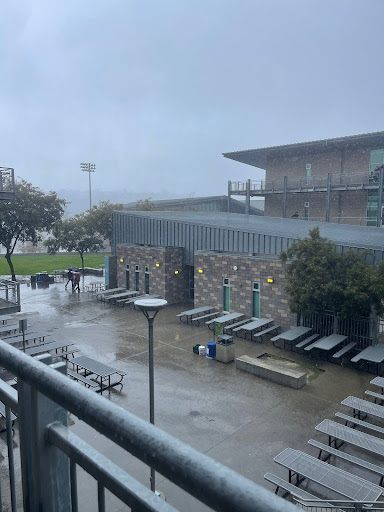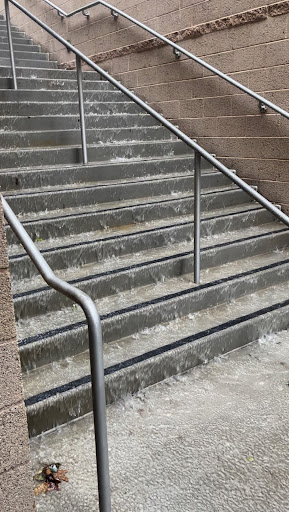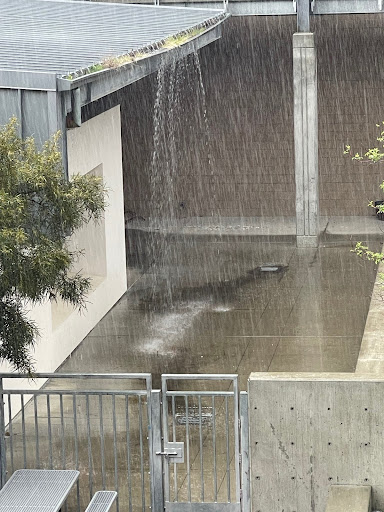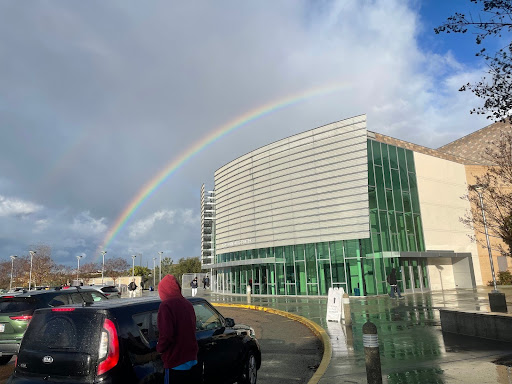Despite living in a state that’s primarily known for the sun and surf, when it rains, it pours, and outdoor California schools end up underwater like Atlantis.
Imagine that instead of frozen water blocking your path, it’s actual liquid running down the stairs of your school like a waterfall as you try to rush to class in five minutes or less. Instead of being able to brush snow off your jacket or hoodie, imagine being soaked to your skin as rain pours endlessly on top of you.
The unideal weather doesn’t only make students wet, tired and highly susceptible to getting sick from being forced to remain in drenched clothes for the day, but it can also create hazards when booking it to class in passing periods. It can be treacherous especially when the underwater staircases throughout the campus of the outdoor school resemble Niagara Falls and hundreds of students are traveling in stop-and-start traffic like the 78 freeway.

It seems that the notion of no rain days is as outdated as the outdoor-based architecture of schools. It’s one thing to have the ability to shovel and plow snow to get to school, but it’s another dynamic when there’s rushing water and no shelter from the storm on the campus itself. Northerners and East Coasters struggle with getting to their indoor school. Students in these places such as California are forced to battle inclement weather upon their bodies where they are putting themselves in harm’s way and at risk for injury and certainly illness.
Speaking of hazards, shelter is scarce on campus. Some California schools don’t even provide overhead coverage for lunch tables and adequate seating for students. Many students rely on welcoming teachers who are willing to open up their classrooms during lunch.
This is a student’s best shot at having a dry landing place to scarf down some food or perhaps do some last-minute studying without ruining their school-issued Chromebooks, personal notebooks or backpacks altogether. California schools tend not to have ample designated cafeterias or other multi-purpose options for students to eat lunch.
Then there’s the matter of each classroom functioning like an autonomous ecosystem. Some teacher’s classrooms feel like a pizza oven where you’re taking off your hoodie, while other classrooms feel like you’re in the Costco frozen tundra where the fruit and vegetables are kept while wearing a t-shirt and shorts. Regardless, wet clothes remain wet, and being drenched in a hoodie and jeans is not the same thing as sitting in a wet bathing suit at the beach.
By the way, here’s a reminder that many California schools do not have lockers, which poses another layer of inconvenience. It’s not like that puffer coat can fit comfortably on the back of your chair at four to six top tables in a packed classroom. Nor are there those adorable little hooks you had back in elementary school that were meant to hold jackets and umbrellas.

Attempting to concentrate on the lesson being taught while you’re soaked and trying to force your numb fingers to dance across the Chromebook keyboard proves much easier said than done.
Never mind the fact that as our drenched sleeves are draped over our work surfaces, we are hard-pressed to find a way to prevent our ever-so-important actual school work from getting ruined. It looks like the family dog water-marked your homework instead of eating it this time.
Apart from frozen fingers, saturated sleeves and the unfortunate feeling that you’ve wet your pants due to the downpour of rain, it’s difficult to muster motivation and concentration under the duress of being drenched.
According to Teach-nology, adverse weather conditions are proven to cause a lack of motivation, drowsiness and difficulty with concentration. Any tranquility of the rain is more like a tranquilizer for students contributing to even more fatigue. During their classes following their adventure out in the rain, students find themselves with a lack of focus as they try to push through their class, their motivation being the final bell ringing allowing them to go home and change into warm dry clothes.
Even a teacher or two tends to be short-tempered on rainy days.
Your clothes don’t dry; rather they get wetter as the day goes on as you’re moving from class to class being continually reintroduced to the rain. It’s not as if towels are provided or there is a housekeeping service that comes during each five-minute passing period to quickly dry off everyone’s desk and seat.
On days when the rain is relentless, students remain doused for all seven hours of the school day. Is this just? Why do states with snow have snow days and states like California who get pummeled with rain and blinding heat have to suck it up and show up to school? Why are California kids left to fend for themselves when it’s a matter of safety?

So how exactly does the decision-making process for inclement weather go across the country? It’s said that southern states do not have resources for salt and sand on the roads, but in California, there isn’t infrastructure to provide shelter for students once they manage to get to school without being involved in an accident due to the flooded streets.
Northern states consider extreme cold harmful. According to Weather Underground, above all else, Department of Transportation (DOT) officials consider student safety the most important aspect and say that should always come first. The National Weather Service is considered a private entity, and while it is valued, ultimately the decision of closure falls on the superintendents.
On the flip side, there are other important considerations such as meals for those who count on school for breakfast and lunch and childcare issues for full-time working parents being the most significant. Then of course there’s the issue of timely makeup work and rescheduled tests.
While science and technology are getting better, forecasts are just that- best guesses. If California school districts are not going to be open to the concept of rain days, then they need to start funding proper shelter and structures on campus to prevent students from getting needlessly sick and hopelessly wet.










Apoorv Pandey ◊ Apr 19, 2024 at 10:59 am
Rainy days would affect the curriculum, and socialness of this generation that’s already lacking, and disallow students that rarely experience the rain to truly experience one of Southern California’s wonders that rarely happen.
Barbara Hart ◊ Apr 12, 2024 at 12:07 pm
Impactful, important & immeasurably enlightening! The safety and health issues you mention Hadley are significant and eye-opening. The pictures are indisputable and capture it perfectly. Your writing is exceptional and hugely illustrative -you did an amazing job expressing what its like from the student’s point of view!